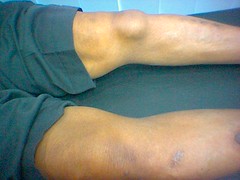
Inflammation of a bursa in the knee. Bursitis may vary in degree from mild irritation to an abscess formation that causes excruciating pain. There are many bursas in the knee:
- In front of and behind the kneecap.
- On both sides of the knee.
- Behind the knee (Baker's cyst).
- Just above the knee (popliteal bursa).
BODY PARTS INVOLVED
- Knee bursas-soft sacs in the knee area filled with lubricating fluid that facilitate motion in the knee.
- Soft tissue surrounding the knee, including nerves, tendons, ligaments, blood vessels (both large vessels and capillaries), periosteum (the outside lining of bone) and muscles.
Causes
- Injury to the knee, especially falling on a bent knee.
- Acute or chronic infection in the knee.
- Arthritis.
- Gout.
- Unknown (frequently).
Signs & Symptoms
- Pain, especially when moving the knee.
- Tenderness.
- Swelling.
- Redness (sometimes) over the affected bursa.
- Fever if infection is present.
- Limitation of motion in the knee.
Treatment
Follow your doctor's instructions. Instructions are supplemental
- Use frequent ice massage. Fill a large styrofoam cup with water and freeze. Tear a small amount of foam from the top so ice protrudes. Massage firmly over the injured area in a circle about the size of a softball. Do this for 15 minutes at a time, 3 or 4 times a day, before workouts or competition.
- After 72 hours, apply heat instead of ice if it feels better.Use heat lamps, hot soaks, hot showers,heating pads or heat liniments or ointments.
- Take whirlpool treatments, if available.
- Use crutches to prevent weight-bearing on the knee ,if needed.
- Whenever possible, elevate the knee above the level of the heart to reduce swelling and prevent accumulation of fluid. Use pillows for propping or elevate the foot of the bed.
- Gentle massage will frequently provide comfort and decrease swelling.
MEDICATION
Your doctor may prescribe:
- Non-steroidal anti-inflammatory drugs.
- Antibiotics if the bursa is infected.
- Prescription pain relievers for severe pain. Use non-prescription aspirin, acetaminophen or ibuprofen (available under many trade names) for mild pain.
- Injection with a long-lasting local anesthetic mixed with a corticosteroid drug, such as triamcinolone.
Physical therapy: Your caregiver may want you to go to physical (FIZ-i-kal) therapy. A physical therapist (THER-ah-pist) can do treatments to help your knees. Exercises to make the muscles and tendons of your knee, thigh, and calf stronger will be started after the bursitis has healed.
- Caregivers may use ultrasound to increase blood flow to the injured area. This may help bursitis heal faster.
- Caregivers may use massage to stretch the tissue and bring heat to the injury, which increases blood flow. This can help your knee heal faster and better.
- You may slowly increase the amount of weight you put on your leg when caregivers say it is OK. You will be told to stop doing any activity or exercise if you feel any pain.
Home Diet
Eat a well-balanced diet that includes extra protein, such as meat, fish, poultry, cheese, milk and eggs. Increase fiber and fluid intake to prevent constipation that may result from decreased activity. Your doctor may suggest vitamin and mineral supplements to promote healing.
Prevention Tips
- Always warm up your muscles and stretch gently before exercising. Do cool-down exercises when you are finished. This will loosen the muscles and tendons in your thigh and calf which will decrease stress on your knees.
- Wear warm clothing in cold weather.
- To prevent recurrence, continue to wear extra knee pads until healing is complete.
No comments:
Post a Comment